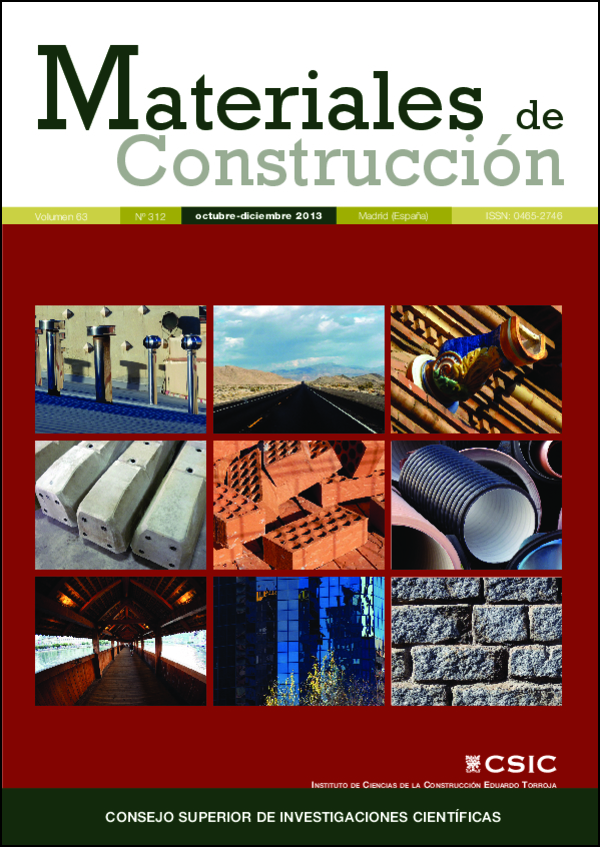Study about the capillary absorption and the sorptivity of concretes with Cuban limestone aggregates
DOI:
https://doi.org/10.3989/mc.2013.04812Keywords:
concrete, limestone aggregate, transport properties, permeability, durabilityAbstract
The objective of this study was to demonstrate the possibility to obtain concretes in Cuba with values of effective porosity below of 10%, using limestone aggregates with high levels of absorption (higher than 1% in many cases), and values of Sorptivity below of 5 x 10-5 m/s1/2 as is established in the document prepared by the DURAR Latin Working Group, for structures exposed to very aggressive environments. The experimental results showed that the use of the trial method of capillary absorption of Göran Fagerlund, were obtained concretes with effective porosity below of the 10%, for water/cement ratios of 0.4 and 0.45, but the values of sorptivities were very high. Nevertheless the subsequent use of the trial method of the ASTM C1585, that use cylinders probes with bigger depth and different processing, permits to obtain the desired sorptivity values for water/cement ratios of 0.4 and 0.45 whenever would be fulfilled the Good Practices of the Construction.
Downloads
References
(1) Neville A.; Brooks J., Tecnología del concreto. P. 205 D.F., Editorial Trillas, México D.F. (1992).
(2) Castañeda A.; Corvo F.; Howland J.; Pérez T. “Atmospheric Corrosion of concrete reinforced bars in tropical coastal regions”. Memories of the European Congreso of Corrosión (EUROCOR 2011). Stocolm, Sweden. September 2011.
(3) International Standard ISO 9223:1992 “Corrosion of metals and alloys - Corrosivity of atmospheres. Classification”.
(4) Uller L.; Troconis de Rincón O., et al. Manual for inspecting, evaluating and diagnosing corrosion in reinforced concrete structures, DURAR Thematic Network XV.B. Durability of rebars, CYTED Iberoamerican Program Science and Technology for Development, Maracaibo, Venezuela, (1998).
(5) Fagerlund G. “On the Capillarity of concrete” Nordic Concrete Research. Oslo, Noruega. Vol. Diciembre (1982).
(6) Cuban Standard: NC 345:2011 “Hormigón endurecido - Determinación de la absorción de agua por capilaridad”.
(7) Spanish Standard: UNE 83982 “Durabilidad del hormigón. Métodos de ensayo. Determinación de la absorción de agua por capilaridad del hormigón endurecido. Método de Fagerlund.
(8) Cuban Standard: NC 120:2007 “Hormigón hidráulico - Especificaciones”
(9) Nor American Standard ASTM C642-06 (2006) “Standard Test Method for Density, Absorption, and Voids in Hardened Concrete”
(10) Bernal S.; Mejía de Gutierrez R. et al. “Effect of binder content on the performance of alkali-activated slag concretes”. Cement and Concrete Research, Vol. 41 (2011) pp.1-8. http://dx.doi.org/10.1016/j.cemconres.2010.08.017
(11) Nor American Standard: ASTM C 1585-04 (2004) “Standard test method for measurement of rate of absorption of water”
(12) Cuban Standard: NC 95:2001 “Cemento Pórtland. Especificaciones”
(13) Cuban Standard: NC 251:2005 “Áridos para hormigones hidráulicos - Requisitos”
(14) Cuban Standard: NC 228-1:2005 “Aditivos para hormigones, morteros y pastas - Parte 1 Aditivos para hormigón. Requisitos
(15) Nor American Standard: ASTM C211.1-91 (reaprobada en el 2002) “Práctica normativa para seleccionar las proporciones de un hormigón Normal, de alta densidad y masivo”
(16) O´Reilly V. Método de dosagem de concreto de elevado desempenho PINI Ltda. Sao Paulo. Brazil. (1998).
(17) Bickley J.; Hooton R.; Hover K.; “Performance Specifications for Durable Concrete. Current Practices and Limitations”. Concrete International. USA. September (2006).
(18) Obla K.; Lobo C. “Experimental case of demostrative study about the advantages of the performance specifications”. RMC Research Foundation (NRMCA Initiative P2P). Enero 2006
Downloads
Published
How to Cite
Issue
Section
License
Copyright (c) 2013 Consejo Superior de Investigaciones Científicas (CSIC)

This work is licensed under a Creative Commons Attribution 4.0 International License.
© CSIC. Manuscripts published in both the print and online versions of this journal are the property of the Consejo Superior de Investigaciones Científicas, and quoting this source is a requirement for any partial or full reproduction.
All contents of this electronic edition, except where otherwise noted, are distributed under a Creative Commons Attribution 4.0 International (CC BY 4.0) licence. You may read the basic information and the legal text of the licence. The indication of the CC BY 4.0 licence must be expressly stated in this way when necessary.
Self-archiving in repositories, personal webpages or similar, of any version other than the final version of the work produced by the publisher, is not allowed.
















